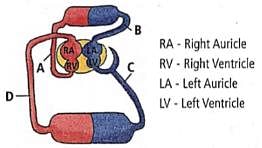Test: Human Circulatory System (NCERT) - NEET MCQ
15 Questions MCQ Test NCERTs at Fingertips: Textbooks, Tests & Solutions - Test: Human Circulatory System (NCERT)
Heart pumps blood more forcefully in older persons than younger ones due to
Read the following statements and select the correct option.
Statement 1: The SA node acts as pacemaker.
Statement 2: The SA node is located in the wall of the right atrium near the inter-atrial septum.
Statement 1: The SA node acts as pacemaker.
Statement 2: The SA node is located in the wall of the right atrium near the inter-atrial septum.
| 1 Crore+ students have signed up on EduRev. Have you? Download the App |
Which of the following walls separate the right and left atria?
Find the incorrect answer from the following?
Read the following statements and select the correct ones.
(i) Nodal tissue is specialised cardiac musculature in human heart which has the ability to generate action potential due to an external stimuli
(ii) Position of SAN - right corner of right atrium
(iii) Position of AVN - right corner of ventricle
(iv) AV bundle continues from AVN
(v) Purkinje fibres are modified cardiac muscle fibres that originate from the atrioventricular node and spread into the two ventricles.
In the above diagram, which blood vessel represents vena cava?

The given figure illustrates a section through the human heart.

Which labelled part represents the site for the generation of action potential in human heart?
In which one of the following pairs, two terms represent the same thing?
In veins, valves are present to check backward flow of blood flowing at:
Which of the following chambers of the heart has the thickest muscular wall?
|
304 docs|275 tests
|
|
304 docs|275 tests
|












